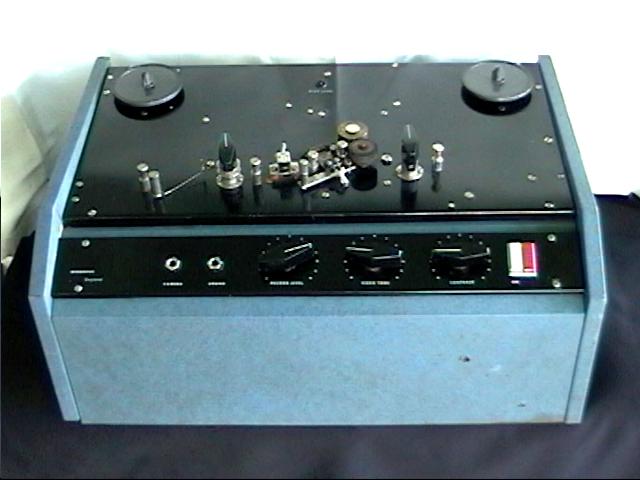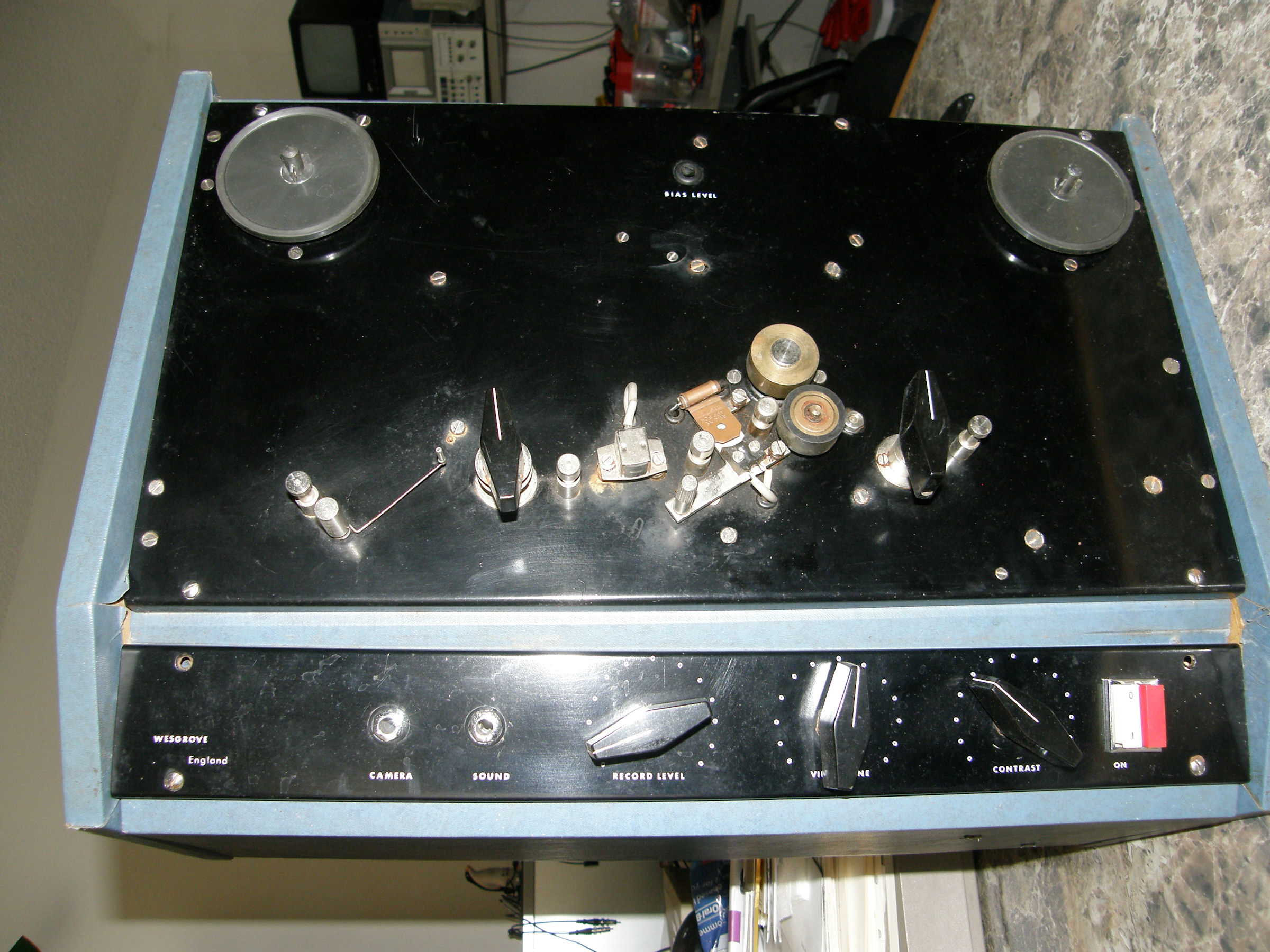LabGuy's World: - Wesgrove VKR-500 Restoration

The World's First Home VTR circa 1964 - 20160507 Heavy emphesis on FIRST! AND it was a build it yourself KIT! There is no other consumer video tape recorder available prior to this miracle of early nineteen sixties technology. Developed in 1963 by Norman Rutherford and Michael Turner of Great Britain. Using the longitudinal recording method, this machine streams very thin quarter inch audio recording tape past a stationary record / play head at 60, 90 or 120 inches per second! That results in twenty minutes recording time on 11.5 inch reels of half mil audio tape. The kit version of the VTR started shipping in 1965. There are several popular articles in the references, located att he very bottom of this page, from that period. This very machine was previously owned by John Fletcher. Four years ago or so, John and I were exchanging friendly banter, via email, about the restoration of this deck. John's Wesgrove recorder is missing the video recording head. I have a Wesgrove video recording head missing the entire video recorder. I would say, "Send me the machine", and John would reply, "Send me the head." We were in our third interation of this when John fell silent. I presumed I had irritated him. Several attempts to reconnect over the years had failed as well. Recently, a message was posted in a discussion forum announcing a video equipment collection for sale. I was examining the photos, when I spotted the VKR-500 in the background. As I enquired about the machine, I learned that it was the very deck owned by John Fletcher. He had passed away unexpectedly in 2013. He was 38 years old. I convinced his father that the Wesgrove VTR would be well preserved in my collection, as well as potential restoration. We struck a deal and I was able to purchase the recorder. This VKR-500 came very close to being lost to obscurity. Virtually no one would recognize it for what it really is. There are virtually no external markings of note. It could have as easily ended up in recycling. I assure you, at the end of the restoration, this VTR will be clearly labeled as to its pedigree and historical value. A video that shows the Telcan prototype in actual operation in 1963 - 20160507 The prototype model of this machine was called the Telcan. Because, it could can television! Cute hook. When they introduced this VTR in kit form, it became known as the Wesgrove VKR-500. This video shows the Telcan VTR in operation in 1963. It also includes a visit to the museum display of a VKR-500 and a relatively recent interview with Norman Rutherford. He discusses how the business evolved, and ultimately failed, over time. 
Wesgrove VKR-500 VTR as received - 20160514 I received the VKR-500 on May 12, 2016. The packing was not up to the job and there was some inevitable damage to the machine. This is not uncommon. Notice how the control panel top screws are missing from where they ripped free from the wood. The good news: damage is limited to the wooden cabinet. The electronics and mechanism look OK. This thing is built like a tank! Then the first stage of the process will be to repair the cabinet damage. The transport must be disassembled completely and rebuilt from the ground up. There is a lot of rust that needs to be removed. In the photo, the VTR is standing on end and the image is rotated. The cross members are broken loose and will not support the weight of the transport plate if set level. 


The printed circuit board will be removed and recapped before any attempt is made to power it up. The transformers in the unit are very rusty and may need replacement. The small transformer, upper left of middle photo, powers the electronics. The larger transformer was probably not in the British version of the machine. It is a step up auto transformer used to raise 115 volts up to 240 volts to operate the British made, one tenth of a horse power, industrial quality AC motor. The AC motor is frozen solid. No rotation at all. It will need to come out and be serviced. I plan to install new ball bearings. Being an industrial grade motor, it is highly likely any well equipped AC motor service shop can rebuild it. 
VKR-500 Recording and Playback head system - 20050303 If the video head that I have is good, then the odds of making this machine operate are very good. I would say 88% plus. I obtained this video recording head from Brian Smith, the mechanical engineer at Wesgrove in the glory days of 1963. Mr. Smith was in his 90s at the time that we met over eleven years ago. He donated this unused video head assembly to my museum. The head consists of a copper alloy block into which is embedded a very thin mu metal strip. This head is fabricated from two halves that mated together to form the whole. Placed between them, as separator, is a sheet of hand beaten aluminum foil only 4/1,000,000 of an inch thick! This forms the precise gap width necessary for the head to function. The electromagnetic coil assembly, the black object with two electrical contacts protruding, is separate from the gap forming magnetics in this design. A tiny ferrite ring is used. A gap is cut through it using a tiny wire saw. The finished product resembles the letter C. Onto this c-core, 16 turns of AWG 39 copper wire are wrapped opposite the gap. The ends of this coil are attached to the contact posts and the entire item is potted in plastic. In operation, the tape passes between both the coper head block and the black plastic drive coil. When energized, the coil of wire induces magnetic force in the ferrite ring that exits the ring where the gap is cut, passes right through the recording tape and is concentrated by the mumetal poles in the copper head. The weak field of the ferrite torroid is concentrated to very high power at the recording gap. Away from the gap, the field is not strong enought to effect the tape and passes through it harmlessly. This is a brilliant piece of engineering, far ahead of its time! 
Wesgrove VKR-500 VTR - with repaired cabinet and take up reel - 20160524 The VTR with the cabinet repaired and awaiting a video head and tape. Well. It's not quite that simple. Still need to unstick the main motor, rebuild the capstan pinch roller and many other things too. These restorations jobs go one step at a time. I've made a modificaion to the front panel of the box, which used to be permanently attached. It is now removable for servicing. This makes it much easier to install and remove the tape transport. I have purchased two 3600 foot reels of brand new BASF recording tape. Got these on Ebay and they are coming from Bulgaria. The 10.5 inch take up reel was purchased because it matches the reels of recording tape as well. At 150 IPS (inches per second), each reel will provide 4 minutes and 45 seconds of running time on one side of the tape! The original tape for this machine was .5 mil thick and twice as long. It gave almost 10 minutes recording time per side. Being a half track format, when side one runs out, flip the reels and record on side two. Just like most common audio tape recorders. 

Wesgrove VKR-500 VTR - With 10.5 inch reel of RMGI LPR 35 1/4" tape - 20160527 We are almost there. Soon, the machine will be complete and the functional restoration can begin. I will be off to the storage units tomorrow in search of the video recording head. When I moved a couple of years ago, the darned thing got packed away. I think I know where it is. I am going to trust my instincts. Stay tuned! This is an on going project. Check back from time to time to follow the progress. REFERENCES: 1. Web page [My earliest information for this VTR.] Orignal Wesgrove extinct VTR catalog page at Labguy's World. 2. YOUTUBE [Telcan - A British First in Home Video Recording] By Barrie Blake-Coleman. Running time: 2:30 3. Web page [Total Rewind] The Virtual Museum of Vintage VCRs, by Andy Hain, who is also participating in this restoration. 4. PDF file [Electronics Illustrated] Tests a HOME VIDEO TAPE RECORDER - September 1965 5. PDF file [Popular Science] Builds a HOME VIDEO TAPE RECORDER - August 1965 6. PDF file [Radio Electronics] We built a HOME VIDEO TAPE RECORDER - June 1965 [HOME] [ELECTRONICS PROJECTS] Created: May 7, 2016 Last updated: May 27, 2016 |